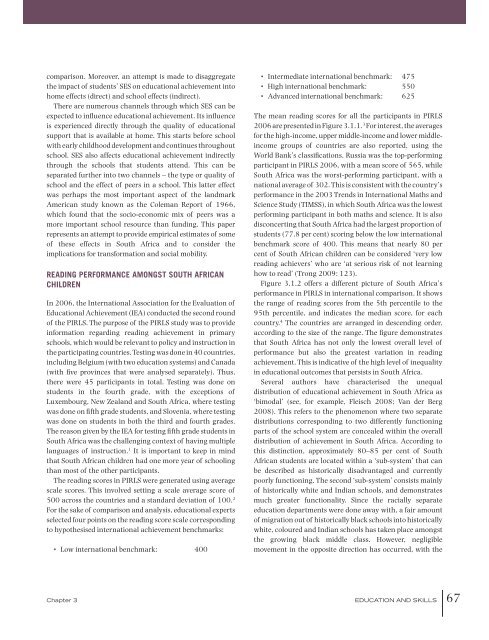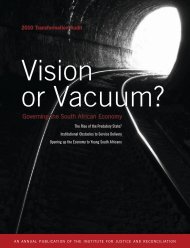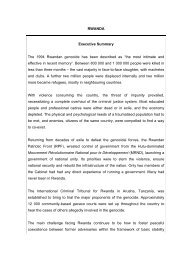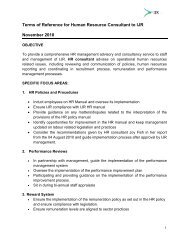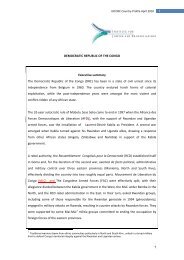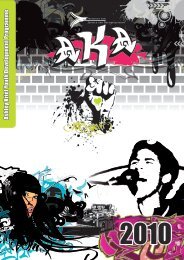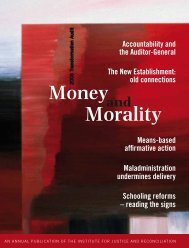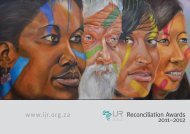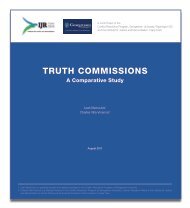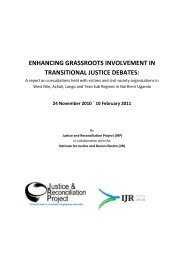CHAPTER 3 Education and skills - Institute for Justice and ...
CHAPTER 3 Education and skills - Institute for Justice and ...
CHAPTER 3 Education and skills - Institute for Justice and ...
You also want an ePaper? Increase the reach of your titles
YUMPU automatically turns print PDFs into web optimized ePapers that Google loves.
comparison. Moreover, an attempt is made to disaggregatethe impact of students’ SES on educational achievement intohome effects (direct) <strong>and</strong> school effects (indirect).There are numerous channels through which SES can beexpected to influence educational achievement. Its influenceis experienced directly through the quality of educationalsupport that is available at home. This starts be<strong>for</strong>e schoolwith early childhood development <strong>and</strong> continues throughoutschool. SES also affects educational achievement indirectlythrough the schools that students attend. This can beseparated further into two channels – the type or quality ofschool <strong>and</strong> the effect of peers in a school. This latter effectwas perhaps the most important aspect of the l<strong>and</strong>markAmerican study known as the Coleman Report of 1966,which found that the socio-economic mix of peers was amore important school resource than funding. This paperrepresents an attempt to provide empirical estimates of someof these effects in South Africa <strong>and</strong> to consider theimplications <strong>for</strong> trans<strong>for</strong>mation <strong>and</strong> social mobility.READING PERFORMANCE AMONGST SOUTH AFRICANCHILDRENIn 2006, the International Association <strong>for</strong> the Evaluation of<strong>Education</strong>al Achievement (IEA) conducted the second roundof the PIRLS. The purpose of the PIRLS study was to providein<strong>for</strong>mation regarding reading achievement in primaryschools, which would be relevant to policy <strong>and</strong> instruction inthe participating countries. Testing was done in 40 countries,including Belgium (with two education systems) <strong>and</strong> Canada(with five provinces that were analysed separately). Thus,there were 45 participants in total. Testing was done onstudents in the fourth grade, with the exceptions ofLuxembourg, New Zeal<strong>and</strong> <strong>and</strong> South Africa, where testingwas done on fifth grade students, <strong>and</strong> Slovenia, where testingwas done on students in both the third <strong>and</strong> fourth grades.The reason given by the IEA <strong>for</strong> testing fifth grade students inSouth Africa was the challenging context of having multiplelanguages of instruction. 1 It is important to keep in mindthat South African children had one more year of schoolingthan most of the other participants.The reading scores in PIRLS were generated using averagescale scores. This involved setting a scale average score of500 across the countries <strong>and</strong> a st<strong>and</strong>ard deviation of 100. 2For the sake of comparison <strong>and</strong> analysis, educational expertsselected four points on the reading score scale correspondingto hypothesised international achievement benchmarks:• Low international benchmark: 400• Intermediate international benchmark: 475• High international benchmark: 550• Advanced international benchmark: 625The mean reading scores <strong>for</strong> all the participants in PIRLS2006 are presented in Figure 3.1.1. 3 For interest, the averages<strong>for</strong> the high-income, upper middle-income <strong>and</strong> lower middleincomegroups of countries are also reported, using theWorld Bank’s classifications. Russia was the top-per<strong>for</strong>mingparticipant in PIRLS 2006, with a mean score of 565, whileSouth Africa was the worst-per<strong>for</strong>ming participant, with anational average of 302. This is consistent with the country’sper<strong>for</strong>mance in the 2003 Trends in International Maths <strong>and</strong>Science Study (TIMSS), in which South Africa was the lowestper<strong>for</strong>ming participant in both maths <strong>and</strong> science. It is alsodisconcerting that South Africa had the largest proportion ofstudents (77.8 per cent) scoring below the low internationalbenchmark score of 400. This means that nearly 80 percent of South African children can be considered ‘very lowreading achievers’ who are ‘at serious risk of not learninghow to read’ (Trong 2009: 123).Figure 3.1.2 offers a different picture of South Africa’sper<strong>for</strong>mance in PIRLS in international comparison. It showsthe range of reading scores from the 5th percentile to the95th percentile, <strong>and</strong> indicates the median score, <strong>for</strong> eachcountry. 4 The countries are arranged in descending order,according to the size of the range. The figure demonstratesthat South Africa has not only the lowest overall level ofper<strong>for</strong>mance but also the greatest variation in readingachievement. This is indicative of the high level of inequalityin educational outcomes that persists in South Africa.Several authors have characterised the unequaldistribution of educational achievement in South Africa as‘bimodal’ (see, <strong>for</strong> example, Fleisch 2008; Van der Berg2008). This refers to the phenomenon where two separatedistributions corresponding to two differently functioningparts of the school system are concealed within the overalldistribution of achievement in South Africa. According tothis distinction, approximately 80–85 per cent of SouthAfrican students are located within a ‘sub-system’ that canbe described as historically disadvantaged <strong>and</strong> currentlypoorly functioning. The second ‘sub-system’ consists mainlyof historically white <strong>and</strong> Indian schools, <strong>and</strong> demonstratesmuch greater functionality. Since the racially separateeducation departments were done away with, a fair amountof migration out of historically black schools into historicallywhite, coloured <strong>and</strong> Indian schools has taken place amongstthe growing black middle class. However, negligiblemovement in the opposite direction has occurred, with theChapter 3EDUCATION AND SKILLS 67


